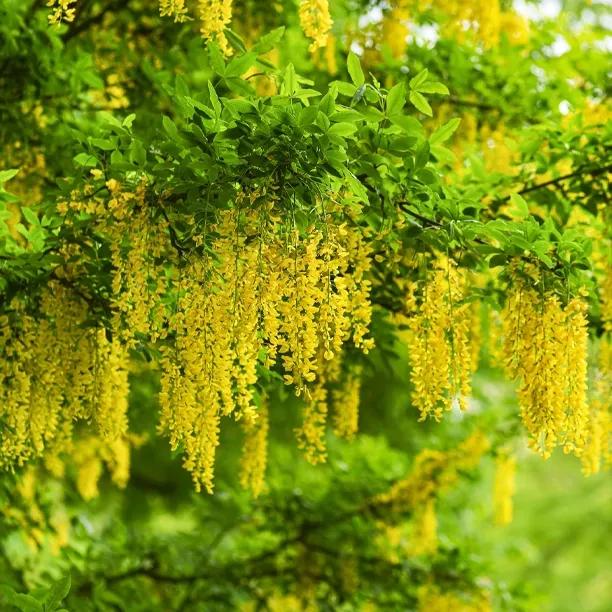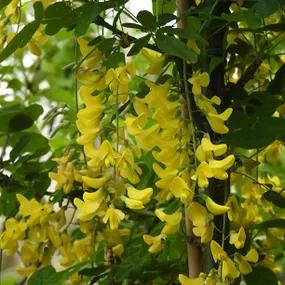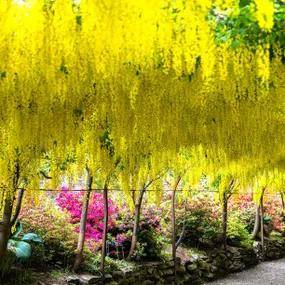Golden Rain Laburnum, Large Trees
The details
- Long strings of yellow flowers.
- Any soil with decent drainage.
- Max Height 9m
- RHS Award of Garden Merit
- Bareroot Delivery.
Recommended extras
Description
Laburnum x watereri Vossii: Bareroot Vos's Golden Rain Trees in Standard Sizes
Laburnum Vossii, the Golden Rain tree, has much longer (up to 50-60cm) and better flowers than the wild variety, with the same lovely bark and quite dark green leaves for the flowers to stand out against. The flowers are fragrant and good for bees.
Left to grow freely, they can reach a height of about 8-9 metres and up to the same wide, but they respond well to pruning and can be trained over pergolas.
Browse our other trees.
Delivery season: Laburnum trees are delivered bareroot during late autumn and winter, approximately November-March inclusive.
Choosing a size: Small trees are cheaper, easier to handle and more forgiving of less than ideal aftercare, so they are best for a big planting project. If instant impact is your priority, or if you are only buying a few plants for use in a place where it is convenient to water them well in their first year, then you may as well use bigger ones. All our bareroot trees are measured by their height in centimetres above the ground (the roots aren't measured).
Features:
- Height: 8-9m
- Soil: Well drained and fertile, full sun
- Long strings of yellow flowers in May-June
- RHS Award of Garden Merit
- Bareroot delivery only: November-March
Growing Golden Rain Laburnums
This hardy tree needs a well-drained and reasonably fertile soil in full to thrive. They tolerate urban pollution well.
If they need pruning, aim to do it between the end of summer to December, otherwise the tree will bleed a lot.
Rabbits love young Laburnum, so you must use a tree guard if there are any in your area.
Planting Instructions
Notes on planting Laburnum vossii trees:
You can grow your trees in any soil, apart from really wet places. Laburnums are a member of the pea family and their roots fix nitrogen into the soil, so they are the perfect tree for sites with poor fertility. They like chalky soil and mature trees are drought hardy. They are shade tolerant, but they need half a day of sun to flower really well.
Prepare your site before planting:
It is good to dig over the site where you plant a tree several months in advance. Kill the weeds first: for tough weeds like nettles, brambles and ground elder, you will usually need a weed-killer to get rid of them. When you dig the soil over, remove stones and other rubbish and mix in well rotted compost or manure down to the depth of about 2 spades.
Watch our video on how to plant a tree for full instructions.
Remember to water establishing trees during dry weather for at least a year after planting.
Tree Planting accessories:
Prepare your site for planting by killing the weeds and grass.
You can buy a tree planting pack with a wooden stake & rubber tie to support the tree and a mulch mat with pegs to protect the soil around the base of your tree from weeds and drying out.
We suggest that you use mycorrhizal "friendly fungi" on the roots of all newly planted large trees: if your soil quality is poor, we strongly recommend it.
You can also improve your soil with bonemeal organic fertiliser.
Did You Know?
Laburnum alpinum and L. anagyroides naturally hybridise in the wild, and to the best of our knowledge the Laburnum x watereri cultivars are derived from plants selected by Knap Hill nurseries in the mid 1800's.
This one was bred in 1875 by C. de Vos in Holland (de Vos means 'the fox').
All parts of the Laburnum are poisonous. Because this variety is mostly sterile, it does not make many seeds, so it is safer for livestock and children.
There are a couple of photos of the Laburnum arch at Bodnant Gardens here.
Standard trees are measured by their girth in centimetres 1 metre above ground level: their trunk's waist measurement. Unlike sapling trees and hedge plants, standards aren't measured by their height, which will vary quite a bit both between and within species.
So, a 6/8cm standard tree has a trunk with a circumference of 6-8cm and an 8/10 standard has a trunk 8-10cm around. This measurement makes no difference to the tree's final height.
On average, standard trees are 2-3.5 metres tall when they arrive, but we cannot tell you precisely how tall your trees will be before we deliver them.





